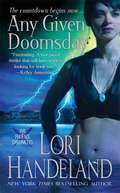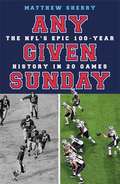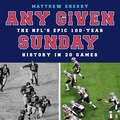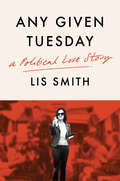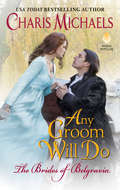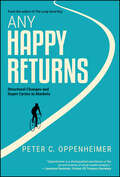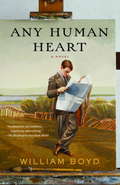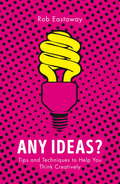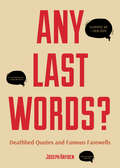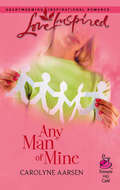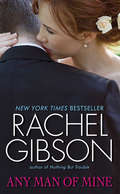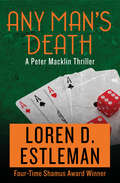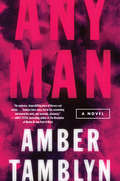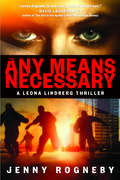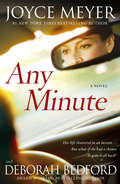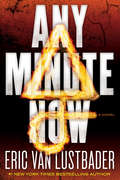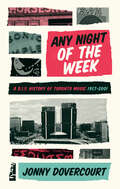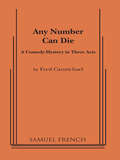- Table View
- List View
Any Given Doomsday (Phoenix Chronicles #1)
by Lori HandelandDarkness will summon her Elizabeth Phoenix once used her unique skills as a psychic to help in the Milwaukee Police Department's fight against injustice. But when Liz's foster mother is found viciously murdered--and Liz is discovered unconscious at the scene of the crime--her only memory of what happened comes in the form of terrifying dreams of creatures more horrific than anything Liz has seen in real life. What do these visions mean? And what in the world do they have to do with her former lover, Jimmy Sanducci? To places she's never been before While the police question Jimmy in the murder, he opens Liz's eyes to a supernatural war that has raged since the dawn of time in which innocent people are hunted by malevolent beings disguised as humans. Only a chosen few have the ability to fight their evil, and Jimmy believes Liz is among them. Now, with her senses heightened, new feelings are rising within Liz--ones that re-ignite her dangerous attraction to Jimmy. But Jimmy has a secret that will rock Liz to her core and put the survival of the human race in peril.
Any Given Monday
by Don Yaeger James R AndrewsFrom tennis elbow to severe trauma, Dr. James Andrews has treated countless sports injuries during his unparalleled medical career. An orthopedic surgeon, well known for performing Tommy John surgeries, and a consultant to some of the fiercest teams in college and professional sports, Dr. Andrews is the father of modern sports medicine and one of the most influential figures in the world of athletics. In Any Given Monday, he distills his practical wisdom and professional advice to combat a growing epidemic of injury among sports' most vulnerable population: its young athletes. Every year more than 3.5 million children will require medical treatment for sports-related injuries, the majority of which are avoidable through proper training and awareness. Any Given Monday is Dr. Andrews's sport-by-sport guide to injury prevention and treatment, written specifically for the parents, grandparents, and coaches of young athletes. From identifying eating disorders to preventing career-ending ACL tears and concussions, Any Given Monday is a compendium of practical advice for every major sport, including football, gymnastics, judo, basketball, tennis, baseball, cheerleading, wrestling, and more. This invaluable guide reveals how young athletes can maximize their talent and maintain a lifetime of health both on the field and off.
Any Given Sunday: The NFL's Epic 100-Year History in 20 Games
by Matthew Sherry17th September 2020 will mark the centenary of the National Football League. It will reach that landmark as a behemoth, an all-encompassing conglomerate that is the most lucrative sports league in the world - and also the dominant pop culture entity in the United States. The NFL is also making considerable gains worldwide. The International Series has been heading to London since 2007 with incredible sell-outs at the four games in 2019 at Wembley and the Tottenham Hotspur Stadiums.This may lead some to believe the league has always been a roaring success story. History contradicts that reputation, for the NFL of today is a by-product of the humblest beginnings. It is a rocky road filled with genius detours and wrong turns; with heroes and villains; and, most importantly, with thousands of games. Any Given Sunday will detail some of the biggest of those, beginning with the first contest ever played in 1920 and working through to multiple key fixtures from last season. Each chapter will be complemented by countless interviews with some of the game's true legends, from Hall of Fame players and coaches to owners and executives; first-hand accounts from games, including multiple Super Bowls; and, finally, full access to the Pro Football Hall of Fame and NFL Films' extensive archives, including pieces not available to the public.Any Given Sunday takes readers from the boardrooms to the field, into the locker-room and inside the journeys of legends, providing a full snapshot of the NFL's epic first century.
Any Given Sunday: The NFL's Epic 100-Year History in 20 Games
by Matthew SherryAn authoritative 100-year history of America's National Football League from its founding.The NFL has become the most lucrative sports league in the world, yet it has not always been a roaring success story. It is a rocky road filled with detours and wrong turns; with heroes and villains; and, most importantly, with thousands of games. Any Given Sunday recounts twenty of the biggest of those, starting with the first contest ever played in 1920 and working through to key fixtures in the recent past. Each chapter is complemented by interviews with some of the game's true stars; first-hand accounts from games, including multiple Super Bowls; and, finally, full access to the Pro Football Hall of Fame.Matthew Sherry, founder of Gridiron, the UK's only NFL magazine, takes readers from the boardroom to the field, into the locker-room and inside the journeys of legends, providing a full snapshot of the NFL's epic first century.
Any Given Sunday: The Nfl's Epic 100-year History In 20 Games
by Matthew Sherry17th September 2020 will mark the centenary of the National Football League. It will reach that landmark as a behemoth, an all-encompassing conglomerate that is the most lucrative sports league in the world - and also the dominant pop culture entity in the United States. The NFL is also making considerable gains worldwide. The International Series has been heading to London since 2007 with incredible sell-outs at the four games in 2019 at Wembley and the Tottenham Hotspur Stadiums.
Any Given Tuesday: A Political Love Story
by Lis SmithAn irreverent look behind the scenes of American politics from one of the most sought-after operatives in the Democratic PartyLis Smith isn’t your average political strategist and Any Given Tuesday isn’t your typical political memoir. At once a revealing look at human nature at the highest levels of power and an intimate portrayal of a sometimes rocky personal journey, it breaks all the rules. Smith doesn’t pretend to be perfect—she owns the controversial choices that landed her in the tabloids, as well as the unorthodox ones that have paid off and defined her successful career. Any Given Tuesday follows Smith from her earliest experiences as a college-aged intern to her days as a trusted adviser and confidante to some of the most high-profile politicians in the country—including her star turn as senior adviser on Pete Buttigieg’s 2020 presidential campaign. Animated by Smith’s love for the hand-to-hand combat of politics and sustained by her deeply-held belief that it’s still possible to effect positive change, it’s an odyssey full of highs and lows and larger-than-life characters. Throughout, Smith shows what it’s really like behind the curtain: what happens when the lights go down and the cameras turn off, how it feels to be in the eye of the political media storm, and how the people responsible for heady, life and death decisions are as flawed as the rest of us.While the journey hasn’t always been smooth, Lis Smith has seen and learned a lot—and she shares it all in this eye-opening, entertaining memoir.
Any Groom Will Do
by Charis MichaelsLady Willow Hunnicut has always dreamed of living in London. With design talent and aspirations grander than London’s finest houses, she knows an unmarried heiress will never be allowed to live in the capital alone. But a married woman may come and go as she pleases. With a little imagination, a lot of courage, and one carefully worded advertisement, Willow concocts a plan to get everything she wants… even if she must take a husband in exchange. Lord Brent Caulder, the Earl of Cassin, is destitute, his Yorkshire castle is crumbling, and his tenants are without work. He has an ingenious scheme that’s a surefire moneymaker—if only someone would invest. When he discovers an advertisement seeking adventurers to fund, he is determined to claim the money. But his world is turned upside down when the investor turns out to be a flame-haired heiress. The deal is simple: In return for marrying Willow, Cassin will receive her substantial dowry—and nothing else. All she asks is that after the wedding, each go their separate ways. But for all her careful preparation, the one thing Willow couldn’t have planned is the way she feels about Cassin… or the desire that threatens to enflame them both.
Any Happy Returns: Structural Changes and Super Cycles in Markets
by Peter C. Oppenheimer‘An in-depth but accessible analysis of the complex factors that impact structural changes in financial markets and investor opportunities.’ In Any Happy Returns: Structural Changes and Super Cycles in Markets, celebrated author Peter C. Oppenheimer delivers his much-anticipated follow-up to The Long Good Buy. The book discusses how structural changes in macroeconomic drivers, geopolitics, government policy and social attitudes all combine to drive secular super cycles that help to explain investor returns. The author focuses on what he calls the Post-Modern Cycle, what it's likely to look like, how it will unfold and what investors should focus on. You'll also find: An introduction to the history of cycles and structural ‘Super Cycles’, and what has driven them. A detailed analysis of Super Cycles since 1945, including the Post-War Boom, the Great Moderation, the post Global Financial Crisis and Pandemic era. The specific drivers of the emerging Post-Modern Cycle amid a higher cost of capital, bigger governments, more proactive industrial policy, greater regulation, and less globalisation. Oppenheimer focuses on the developments in technology and AI, and on efforts to de-carbonise economies, and how these might impact financial market returns and opportunities. An invaluable resource for students of economic and financial history, and for investors, Any Happy Returns is essential reading for anyone seeking insights into upcoming market conditions and returns.
Any Human Heart (Vintage International)
by William BoydWilliam Boyd’s masterful new novel tells, in a series of intimate journals, the story of Logan Mountstuart—writer, lover, art dealer, spy—as he makes his often precarious way through the twentieth century.From the Trade Paperback edition.
Any Ideas?: Tips and Techniques to Help You Think Creatively
by Rob EastawayEvery great creation starts with a good idea, but where does that special spark come from? How do you recognize the ideas that are worth taking further? And what do you do when your mind goes blank? Ideas are fragile, they need to be nourished, encouraged and shaped. This is a book about how to have ideas and how to nurture them so that you can: • think more creatively • overcome ‘idea killers’ • solve problems more effectively on your own or in a team • evaluate, hone and pitch your ideas • help your ideas become a reality • open your mind to new possibilities and experiences Packed with tips, puzzles and practical techniques, Rob Eastaway will show you that in order to have a good idea you need to have lots of ideas.
Any Last Words?: Deathbed Quotes and Famous Farewells
by Joseph Hayden#1 New Release in Reference & Collections - Last Words of Famous and Infamous PeopleAn Insightful and humorous look into the stories behind the words. From heartwarming, to sad, to straight up quirky, Any Last Words? shares insight from the world’s most interesting figures through the lens of their final words and last moments.Adult and teen gifts for all occasions. If you’re looking for the best gifts for men and women who have everything, you can’t go wrong with the gift of fun facts, inspiration, and wisdom. The last words of some of the most important people in history are great gifts for teens, graduations, or milestone birthdays.Conversation starters and fun facts. Any Last Words? is a great addition to any collection of coffee table books or humor books. Learn and share fun facts about celebrities in the worlds of film, music, art, athletics, literature, politics and more. The quotes in Any Last Words? offer a rare glimpse into the lives of people who left their mark on the world.Any Last Words? celebrates the lives and last words of inspiring and important figures, including:AthletesPoliticiansMusiciansArtistsScientistsCriminalsAny Last Words? is perfect for anyone who appreciates funny and weird gifts. Readers who like The Big Book of Quotes, Lend Me Your Ears, and Movie Quotes for All Occasions will find hours of entertainment in Any Last Words?: Deathbed Quotes and Famous Farewells.
Any Link Between Legal Central Bank Independence and Inflation? Evidence from Latin America and the Caribbean
by Luis I. Jácome Francisco VázquezA report from the International Monetary Fund.
Any Man I Want (The Montgomerys #3)
by Michele Grant"Grant entices, captivates, and mesmerizes." --RT Book ReviewsAs the baby girl of the protective Montgomery clan, Katrina has led a charmed life. A modeling career sky-rocketed her to fame and fortune. Facing thirty, she's ready for a challenge and goes into the fashion design business with her sister-in-law. But in her personal life, the only man Katrina's really drawn to is the one she can't control: former pro footballer, notorious player, and family friend, Carter Evan Parks. Carter has retired from sports--and womanizing--to build a successful real estate career. Now he wants to get serious in his love life--with Katrina. Trouble is, dating his best friend's pampered sister could go wrong in so many ways, especially under the watchful eyes of the Montgomerys. But what happens when a girl who can have any man chooses one who won't be toyed with? "Readers will love the fast-paced action as well as the unorthodox romance." --RT Book Reviews, 4.5 Stars, Top Pick"For fans who enjoy a juicy somethin' mixed into a romantic tale." --Library Journal
Any Man of Mine
by Carolyne AarsenLiving with three brothers has taught me what I don't want in a husband. "Guys" who can only converse about farming, welding and hockey won't cut it. And those who prefer a rodeo to a symphony or dusty jeans to a nice suit are not for me. Unfortunately, my hometown is full of guys just like my brothers. So I've been planning to move to the city for a fresh start. But now I'm having second thoughts. There's a new man in town. . . ;a churchgoer who's cultured, wears suits and, most important, is nothing like my brothers.
Any Man of Mine
by Rachel GibsonWhat happens in Vegas . . . doesn't always stay there.Autumn Haven's Las Vegas "to-do" list said to catch a show and play the slots--not wake up married to a sexy jerk like Sam LeClaire. The first moment she saw him eyeing her like a luscious piece of the dessert buffet, her usually responsible self told her to run. And she did--right into the wildest fantasy weekend of her life. But Monday morning jolted her back to reality, and before she could say "pass the coffee," Sam was gone.Now a successful wedding planner, Autumn hasn't clapped eyes on the heartbreaking hockey superstar for over two years . . . until she organizes his teammate's "Special Day," where Sam makes a big play to pick up where he left off! But she has vowed any man of hers plays for keeps. Is Sam the man for her or does she banish him to the sin bin forever?
Any Man's Death (The Peter Macklin Thrillers #3)
by Loren D. EstlemanA Detroit mob war draws Peter Macklin back into his old life as a Mafia assassin in award-winning author Loren D. Estleman&’s riveting hard-boiled thriller The Reverend Thomas Aquinas Sunsmith is halfway through his sermon when killers open fire. He is preaching against the evils of gambling, which a cartel of mobsters is trying to legalize in Detroit. The hail of gunfire misses the reverend, but a choir member is cut down—the first victim in the battle for the soul of the Motor City. The Detroit mob has erupted into civil war, and professional killer Peter Macklin is caught in the middle. A former mob employee, he has since tried to stay away from the savagery of organized crime, but now they&’re offering him a job too tempting to refuse. The mob will kill whomever it takes to bring gambling to Detroit, and Macklin is about to discover their secret weapon: a seventeen-year-old prodigy assassin, who happens to be Macklin&’s own son. This suspenseful thriller from the three-time Shamus Award–winning author of the Amos Walker Mysteries rumbles with hard-boiled action and razor-sharp dialogue. Any Man&’s Death is the 3rd book in the Peter Macklin Thrillers, but you may enjoy reading the series in any order.
Any Man: A Novel
by Amber Tamblyn“An explosive, shapeshifting piece of literary real estate, Amber Tamblyn’s arresting debut offers a scathing portrait of American celebrity culture and the way in which it transmutes human tragedy into a vicious circus; victims are forgotten as likes and shares swirl, and ‘news’ becomes a squalid orgy, a lurid feast. Tamblyn takes every risk in this astonishing and innovative work, and succeeds, gloriously.” — Janet Fitch, bestselling author of The Revolution of Marina M. and Paint It BlackVanity Fair's Summer Ultimate Fiction ListEntertainment Weekly Summer Preview ListIn this electric and provocative debut novel, Tamblyn blends genres of poetry, prose, and elements of suspense to give shape to the shocking narratives of victims of sexual violence, mapping the destructive ways in which our society perpetuates rape culture.A violent serial rapist is on the loose, who goes by the name Maude. She hunts for men at bars, online, at home— the place doesn’t matter, neither does the man. Her victims then must live the aftermath of their assault in the form of doubt from the police, feelings of shame alienation from their friends and family and the haunting of a horrible woman who becomes the phantom on which society projects its greatest fears, fascinations and even misogyny. All the while the police are without leads and the media hound the victims, publicly dissecting the details of their attack. What is extraordinary is how as years pass these men learn to heal, by banding together and finding a space to raise their voices. Told in alternating viewpoints signature to each voice and experience of the victim, these pages crackle with emotion, ranging from horror to breathtaking empathy.As bold as it is timely, Any Man paints a searing portrait of survival and is a tribute to those who have lived through the nightmare of sexual assault.
Any Means Necessary: A Leona Lindberg Thriller
by Jenny Rogneby"Jenny Rogneby is the new queen of Nordic noir. Her heroine is like no one else. And the way she writes! She grabs you and you just can't stop reading." —David Lagercrantz, author of the #1 best-selling The Girl in the Spider's WebIn the highly anticipated sequel to Leona: The Die Is Cast, a corrupt detective deals with the emotional fallout of her actions while investigating a terrorist attack in the heart of Stockholm.A man blows himself up outside the Parliament House in Stockholm, but miraculously survives. Was he a lone wolf, or are there more heinous acts to follow? Leona Lindberg is put on the case. But Leona, who has barely escaped her trials from the last case, is focused on other things. Her family is shattered, she is living under threat, and desperately needs liquid assets. It's lucky then, that she can think outside the box like no other detective. With one foot on each side of the law, she mounts a special operation of grand proportions. And the higher the risk, the higher the rewards.
Any Minute
by Joyce MeyerNew York Times bestselling authors Joyce Meyer and Deborah Bedford bring readers the compelling story of a woman who must experience death in order to understand life
Any Minute I Can Split
by Judith RossnerFrom the New York Times bestselling author of Looking for Mr. Goodbar--after running away to a commune, Margaret Adams discovers the joys, burdens and limits of family.When Margaret Adams, 250 pounds and pregnant, decides to leave her life behind and take to the open road on a motorcycle stolen from her nutty husband Roger, she doesn't know where her future will take her. Quickly she meets David, a withdrawn nineteen-year-old hitchhiker who leads her to a communal farm in Vermont. There she discovers an unusual makeshift family who teach her about herself, her relationships, and the joys and burdens of the family you choose and the family that chooses you.
Any Minute Now: A Novel (Red Rover Ser. #01)
by Eric Van LustbaderFrom Eric Van Lustbader, the New York Times bestselling author of the Jason Bourne series come Any Minute Now.Red Rover is broken, finished, dead. The blackest of black ops teams is betrayed on its top-priority mission to capture and interrogate a mysterious Saudi terrorist. One of their own is killed, the remaining two barely get home alive. Then without warning or explanation the mission is shut down.Greg Whitman and Felix Orteño are left adrift in a world full of deathly shadows, blind alleys, and unanswerable questions. Into their midst comes Charlize Daou, a brilliant, wildly talented arms expert with a past entangled with Whit's. Though Charlie grapples with damage of her own, she becomes their new center, their moral compass, and their reason for resurrecting Red Rover.Despite Whit's seemingly super-normal abilities it is Charlie, fully rooted in reality, who recognizes that both Whit and Felix have lost parts of themselves. And it is she who possesses the true power necessary for survival: the power to heal, to forgive, and to bring these two lost souls back from the demonic spiritual darkness into which they have fallen.Ignoring their new orders, Red Rover secretly sets out to find the protected Saudi terrorist, the first step in a perilous journey into the heart of a vast conspiracy that involves the NSA, a cabal of immensely wealthy mystics known as the Alchemists, and an ageless visionary out to create an entirely new way of waging war. A war that will destabilize one of the great super-powers and forever rearrange the balance of power across the entire globe.At the Publisher's request, this title is being sold without Digital Rights Management Software (DRM) applied.
Any Minute: A Novel
by Joyce Meyer Deborah BedfordSarah Harper is driven to achieve success no matter what the cost. She wants to do good and not hurt the people she loves--especially children and her husband, Joe--but her desire to succeed in her career too often leaves little time for family. One cold, autumn afternoon, all of that changes when Sarah's car plunges off a bridge and into a river. She is presumed dead by those on the "outside," but Sarah's spirit is still very much alive. What she discovers on the other side transforms everything about Sarah's view of life--past, present, and future. When Sarah is revived, she is a changed woman. And the unsuspecting world around her will never be the same again.
Any Night of the Week: A D. I. Y. History Of Toronto Music, 1957-2001
by Jonny DovercourtThe first book to tell the story of Toronto's massive influence on popular music. Part civic history and part memoir from this veteran scene-builder and founder of the acclaimed Wavelength concert series, From the Top charts the evolution of Toronto's diverse independent music scene in the latter half of the 20th century. From the Yorkville and Yonge Street scenes that spawned Joni Mitchell, Neil Young, and The Band in the '60s, through to the hip-hop, indie rock, and electronica-laden nineties, with acts like Broken Social Scene, Maestro Fresh-Wes, and Peaches, Dovercourt tells the story of how key venues, neighbourhoods, artists and promoters laid the groundwork for this provincial outpost to grow into a music mecca.
Any Night of the Week: A D.I.Y. History of Toronto Music, 1957-2001
by Jonny DovercourtThe story of how Toronto became a music mecca. From Yonge Street to Yorkville to Queen West to College, the neighbourhoods that housed Toronto’s music scenes. Featuring Syrinx, Rough Trade, Martha and the Muffins, Fifth Column, Shadowy Men on a Shadowy Planet, Rheostatics, Ghetto Concept, LAL, Broken Social Scene, and more! “Jonny Dovercourt, a tireless force in Toronto’s music scene, offers the widest-ranging view out there on how an Anglo-Saxon backwater terrified of people going to bars on Sundays transforms itself into a multicultural metropolis that raises up more than its share of beloved artists, from indie to hip-hop to the unclassifiable. His unique approach is to zoom in on the rooms where it’s happened – the live venues that come and too frequently go – as well as on the people who’ve devoted their lives and labours to collective creativity in a city that sometimes seems like it’d rather stick to banking. For locals, fans, and urban arts denizens anywhere, the essential Any Night of the Week is full of inspiration, discoveries, and cautionary tales.” —Carl Wilson, Slate music critic and author of Let’s Talk About Love: A Journey to the End of Taste, one of Billboard’s ‘100 Greatest Music Books of All Time’ “Toronto has long been one of North America’s great music cities, but hasn’t got the same credit as L.A., Memphis, Nashville, and others. This book will go a long way towards proving Toronto’s place in the music universe.” —Alan Cross, host, the Ongoing History of New Music “The sweaty, thunderous exhilaration of being in a packed club, in collective thrall to a killer band, extends across generations, platforms, and genre preferences. With this essential book, Jonny has created something that's not just a time capsule, but a time machine.” —Sarah Liss, author of Army of Lovers
Any Number Can Die
by Fred CarmichaelAn hilarious take off on the mystery plays of the Twenties complete with sliding panels, robed figures, wills being read at midnight, etc. The idioms, costumes, hairdos, and make up of the period add to the thrills and laughter. Four ingenious murders take place in an island mansion as a pair of elderly detectives set to work on their first case. The ever popular storm, the unexpected guests, the cryptic poem, and the missing fortune all add to the intricate and inventive mystery off which the laughs bounce.
